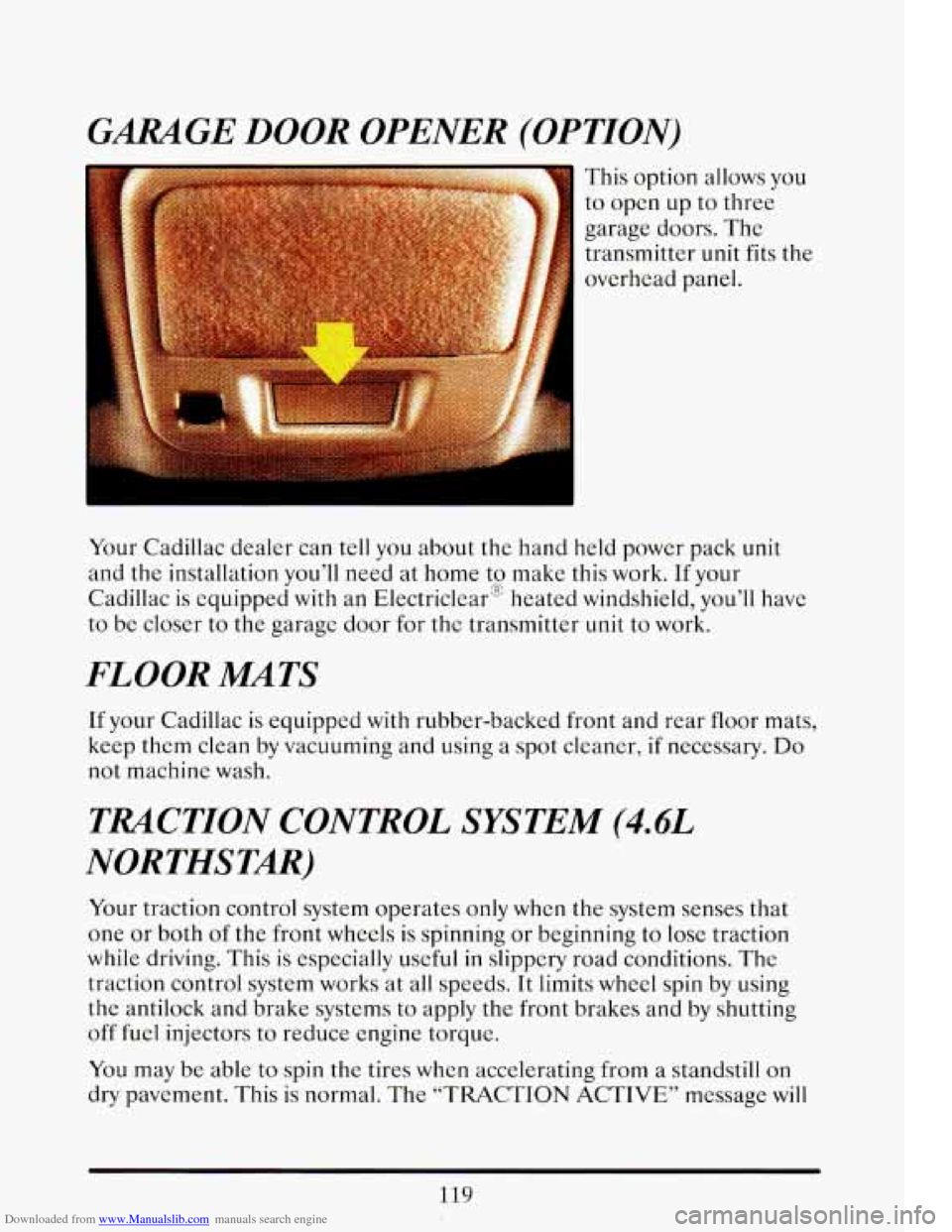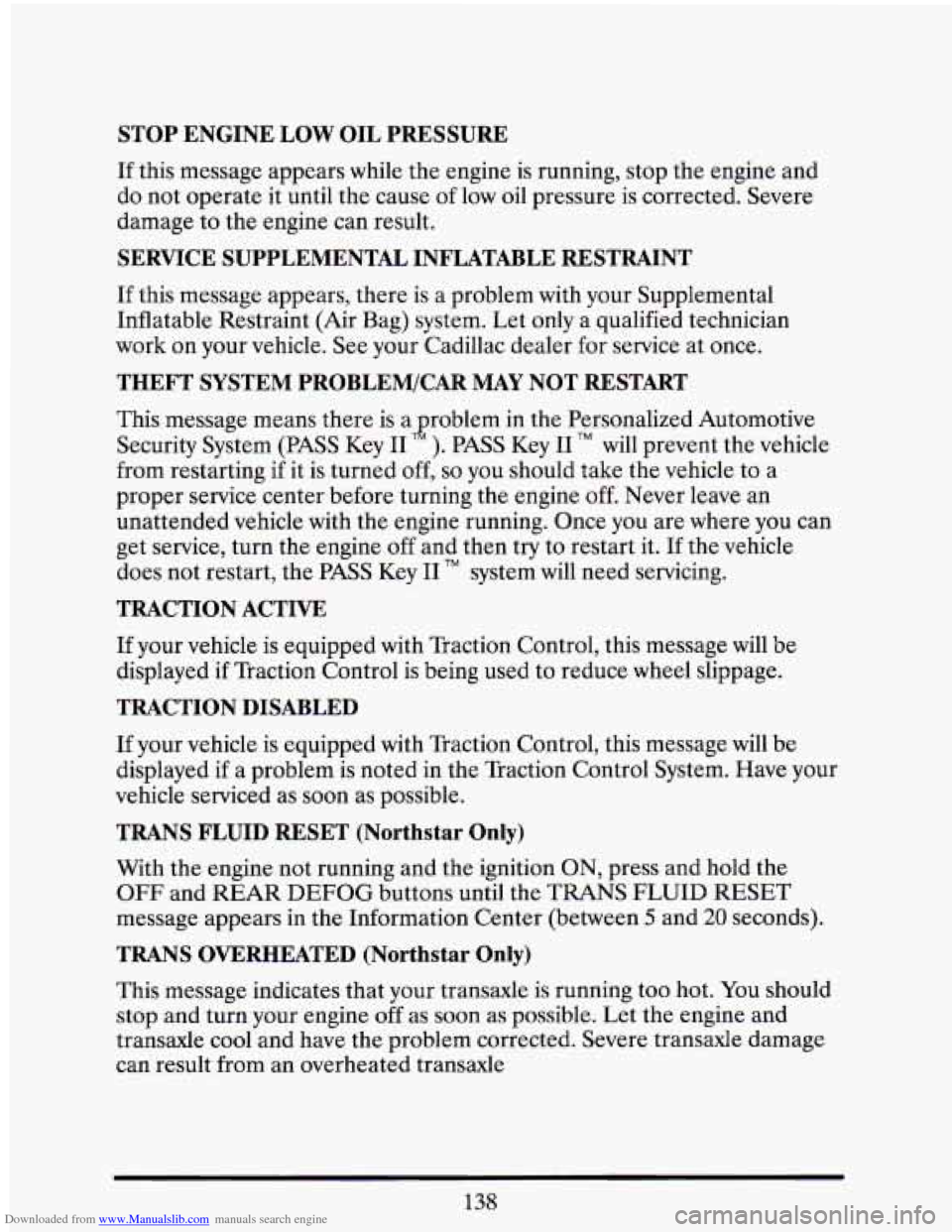Page 94 of 398
Downloaded from www.Manualslib.com manuals search engine AUTOlMATIC TRANSAXLE
Your automatic transaxle may have either a shift lever located on the
steering column or
on the console between the seats.
There are
P.....
R ....
N ....
03 ....
3 .....
2 .....
1 .....
several different positions for your shift lever.
................................................ Park
............................................. Reverse
............................................. Neutral
........................................... Overdrive
........................................ SecondGear
........................................... FirstGear
................................... Third Gear (Drive)
P (Park)
This locks your front wheels. It’s the best position to use when you
start your engine because your vehicle can’t move easily.
80
Page 96 of 398

Downloaded from www.Manualslib.com manuals search engine To rock your vehicle back and forth to get out of snow, ice or sand
without damaging your transaxle, see “If You’re Stuck in Sand, Mud, Ice
or
Snow” in the Index.
N (Neutral)
In this position, your engine doesn’t connect with the wheels. To
restart when you’re already moving, use “N” (Neutral) only. Also, use
“N” when your vehicle is being towed.
A CAUTION:
Shifting out of “P” (Park) or “N” (Neutral) while your engine is
“racing” (running at high speed) is dangerous. Unless your foot
is firmly
on the brake pedal, your vehicle could move very
rapidly. You could lose control and hit people or objects. Don’t
shift out of
“P” (Park) or “N” (Neutral) while your engine is
racing.
Damage to your transaxle caused by shifting out of
“P” (Park
L
0 @ Automatic Overdrive
This position is
for normal driving. If you need more power for
passing, and you’re:
Going less than about
35 mph (56 km/h), push your accelerator
pedal about halfway down.
Going about
35 mph (56 km/h) or more, push the accelerator all
the
way down.
You’ll shift down to the next gear and have more power.
82
Page 100 of 398
Downloaded from www.Manualslib.com manuals search engine If you are on a hill: See “Parking on Hills” in thc Index. That section
shows how to turn your front wheels.
If vou are towing a trailer and are parking; on anv hill: See “Towing a
Trailer” in the Index. That section shows what to do first to keep the
trailer from moving.
SHIFTING INTO ‘CPn (PARK)
I
A CAUTION:
It can be dangerous to get out of your vehicle if the shift lever is
not fully.in “P” (Park) with the parking brake firmly set. Your
vehicle can roll.
If you have left the engine running, the vehicle can move
suddenly.
You or others could be injured. To be sure your vehicle
won’t move, when you’re on fairly level ground, use the
steps
that follow. If you are parking on a hill, or if you’re pulling a
trailer, also see “Parking On Hills” or “Towing a Wailer” in the
Index.
-.
Steering Column Shifl Lever
1. Hold the brake pedal down with your right foot.
86
Page 107 of 398
Downloaded from www.Manualslib.com manuals search engine POWER WINDOWS
The controls are near each window. Here’s
how the master control
I works.
Your vehicle has Retained Accessory Power
(RAP). When you stop your
vehicle and turn the ignition key to “Off”, you can still use your power
windows. The electrical power to operate the windows will not shut
off
until you open a door or 10 minutes has passed. If you want this power
for another
10 minutes, just turn the key to “Run” and back to “Off”.
Express Down Window
The driver’s power window has this feature. Just press the switch once --
for half a second or more -- and then let go. The window will go all the
way down. If you want to stop the window as it is going down, press the
switch again.
HORN
To sound the horn, just press the center of the steering wheel.
93
Page 108 of 398
Downloaded from www.Manualslib.com manuals search engine TILT WHEEL
1
A tilt steering wheel allows you to adjust the steering wheel before you
drive.
You can also raise it to the highest level to give your legs more room
when you exit and enter the vehicle.
To tilt the wheel, hold the steering wheel and pull the levcr. Move the
steering wheel to a comfortable level, then release the lcver to lock the
wheel
in place.
94
Page 115 of 398
Downloaded from www.Manualslib.com manuals search engine CRUISE CONTROL
With Cruise Control, you can maintain a speed of about 25 mph (40
kmih) or more without keeping your foot on the accelerator. This can
really help on long trips. Cruise Control does not work at speeds below
about
25 mph (40 km/h).
When you apply your brakes, the Cruise Control shuts off.
Cruise Control can be dangerous where you can’t drive safely
at a steady speed.
So, don’t use your Cruise Control on
winding roads or in heavy traffic.
Cruise Control can be dangerous on slippery roads. On such
roads, fast changes in tire traction can cause needless wheel
spinning, and
you could lose control. Don’t use Cruise
Control on slippery roads.
To Set Crucse Control
1. Move the Cruise
Control switch
to
“ON ”
101
Page 133 of 398

Downloaded from www.Manualslib.com manuals search engine GARAGE DOOR OPENER (OPTION)
This option allows you
to open up to three
garage doors. The transmitter unit fits the
overhead panel.
Your Cadillac dealer can tell you about the hand held power pack unit
and the installation you’ll need at home to make this work.
If your
CadilIac
is equipped with an Electriclear” heated windshield, you’ll have
to be closer to the garage door for the transmitter unit
to work.
FLOOR MATS
If your Cadillac is equipped with rubber-backed front and rear floor mats,
keep them clean by vacuuming and using a spot cleaner,
if necessary. Do
not machine wash.
TRACTION CONTROL SYSTEM (4.4L
NORTHSTAR)
Your traction control system operates only when the system senses that
one or both of the front wheels
is spinning or beginning to lose traction
while driving. This is especially useful
in slippery road conditions. The
traction control system works at all speeds.
It limits wheel spin by using
the antilock and brake systems to apply the front brakes and by shutting
off
fuel injectors to reduce engine torque.
You may be able to spin the tires when accelerating from a standstill on
dry pavement. This is normal. The “TRACTION ACTIVE” message will
119
Page 152 of 398

Downloaded from www.Manualslib.com manuals search engine STOP ENGINE LOW OIL PRESSURE
If this message appears while the engine is running, stop the engine and
do not operate it until the cause of low oil pressure is corrected. Severe
damage to the engine can result.
SERVICE SUPPLEMENTAL INFLATABLE RESTRAINT
If this message appears, there is a problem with your Supplemental
Inflatable Restraint (Air Bag) system. Let only a qualified technician
work on your vehicle. See your Cadillac dealer for service at once.
THEFT SYSTEM PROBLEM/CAR MAY NOT RESTART
This message means there is atroblem in the Personalized Automotive
Security System (PASS Key
I1 ). PASS Key I1 TM will prevent the vehicle
from restarting if it is turned off,
so you should take the vehicle to a
proper service center before turning the engine off. Never leave an
unattended vehicle with the engine running. Once you are where you can
get service, turn the engine
off and then try to restart it. If the vehicle
does not restart, the PASS Key
I1 TM system will need servicing.
TRACTION ACTIVE
If your vehicle is equipped with Traction Control, this message will be
displayed if Traction Control is being used to reduce wheel slippage.
TRACTION DISABLED
If your vehicle is equipped with Traction Control, this message will be
displayed if
a problem is noted in the Traction Control System. Have your
vehicle serviced as soon as possible.
TRANS FLUID RESET (Northstar Only)
With the engine not running and the ignition ON, press and hold the
OFF and REAR DEFOG buttons until the TRANS FLUID RESET
message appears in the Information Center (between 5 and 20 seconds).
TRANS OVERHEATED (Northstar Only)
This message indicates that your transaxle is running too hot. You should
stop and turn your engine
off as soon as possible. Let the engine and
transaxle cool and have the problem corrected. Severe transaxle damage
can result from an overheated transaxle
138